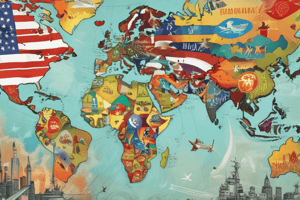Podcast
Questions and Answers
What was the main purpose of the Warsaw Pact?
What was the main purpose of the Warsaw Pact?
- To ensure collective defense against aggression from NATO (correct)
- To ensure freedom of speech and press in Eastern Europe
- To limit the proliferation of nuclear weapons
- To facilitate cultural exchanges between Eastern European countries
Which policy was aimed at preventing the spread of communism particularly in Europe and Asia?
Which policy was aimed at preventing the spread of communism particularly in Europe and Asia?
- SALT
- Brinkmanship
- Glasnost
- Containment (correct)
What characterizes Detente?
What characterizes Detente?
- A policy of openness and transparency in government
- A period of military alliances between North American and European countries
- A period of improved relations between the US and the Soviet Union (correct)
- A strategy of pushing dangerous situations to the brink of war
What is the primary goal of SALT?
What is the primary goal of SALT?
Which leader introduced the policy of Glasnost in the Soviet Union?
Which leader introduced the policy of Glasnost in the Soviet Union?
What was the main strategy behind Brinkmanship during the Cold War?
What was the main strategy behind Brinkmanship during the Cold War?
What was the primary goal of the Truman Doctrine?
What was the primary goal of the Truman Doctrine?
What was the primary purpose of the Marshall Plan?
What was the primary purpose of the Marshall Plan?
What was the primary cause of the Berlin Blockade?
What was the primary cause of the Berlin Blockade?
What was the primary goal of the East vs. West Germany division?
What was the primary goal of the East vs. West Germany division?
What was the primary outcome of the Cuban Missile Crisis?
What was the primary outcome of the Cuban Missile Crisis?
What was the primary purpose of the 38th Parallel?
What was the primary purpose of the 38th Parallel?
Flashcards are hidden until you start studying
Study Notes
Cold War Era
- The Warsaw Pact was a military alliance formed in 1955 between the Soviet Union and its Eastern European satellite states in response to NATO.
- NATO (North Atlantic Treaty Organization) was established in 1949 as a military alliance between North American and European countries aimed at collective defense against Soviet aggression.
Soviet Reforms
- Glasnost, introduced by Mikhail Gorbachev in the late 1980s, referred to a policy of openness and transparency in government, allowing for more freedom of speech and press in the Soviet Union.
- Perestroika, also introduced by Gorbachev, referred to a policy of economic restructuring and reform aimed at revitalizing the Soviet economy and society.
International Relations
- The Strategic Arms Limitation Talks (SALT) were a series of negotiations between the United States and the Soviet Union aimed at limiting the proliferation of nuclear weapons and reducing the risk of nuclear war.
- Detente referred to a period of improved relations between the United States and the Soviet Union during the Cold War, characterized by diplomatic, economic, and cultural exchanges, as well as arms control agreements.
Cold War Strategies
- Containment was a policy adopted by the United States to prevent the spread of communism, particularly in Europe and Asia, through military, economic, and diplomatic means.
- Brinkmanship was a strategy employed by both the United States and the Soviet Union during the Cold War, involving pushing dangerous situations to the brink of war to achieve diplomatic or strategic objectives.
- The Domino Theory believed that if one country fell to communism, neighboring countries would also follow suit.
Global Politics
- The United Nations was an international organization founded in 1945 to promote peace, security, and cooperation among nations, composed of member states from around the world.
- The Cuban Missile Crisis was a tense confrontation in 1962 between the United States and the Soviet Union over Soviet nuclear missiles in Cuba, bringing the world to the brink of nuclear war.
Post-WWII Reconstruction
- The Marshall Plan was an American initiative launched in 1948 to provide economic aid and assistance to Western European countries devastated by World War II, aimed at rebuilding their economies and preventing the spread of communism.
- The Berlin Airlift was a massive humanitarian effort undertaken by the Western Allies in 1948-1949 to supply West Berlin with food and other essentials after the Soviet Union blockaded the city.
Divided Countries
- East vs. West Germany: Following World War II, Germany was divided into East and West Germany, with East Germany under Soviet influence and West Germany under the control of Western Allies, until German reunification in 1990.
- 38th Parallel: The line of latitude that divided North and South Korea following World War II, and later became the border between the two countries after the Korean War.
Other Key Events
- Truman Doctrine: A foreign policy initiative announced by President Harry Truman in 1947, aimed at providing military and economic assistance to countries threatened by communism, particularly in Greece and Turkey.
- China's Civil War: A conflict fought between the Chinese Nationalist Party (Kuomintang) and the Communist Party of China, resulting in the Communist victory and the establishment of the People's Republic of China in 1949.
- Korean War: A conflict fought from 1950 to 1953 between North Korea (supported by China and the Soviet Union) and South Korea (supported by the United States and the United Nations).
Studying That Suits You
Use AI to generate personalized quizzes and flashcards to suit your learning preferences.




